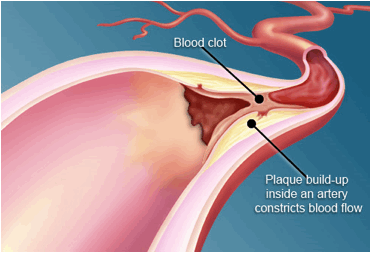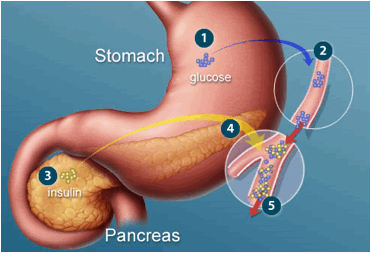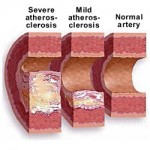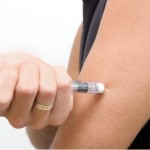What is Glucose?
Our body’s primary source of energy is glucose or sugar. All of our cells use it. The body does not function when there is not enough glucose in our body. Glucose is transported from the intestines or liver to body cells via the bloodstream, and is made available for cell absorption via the hormone insulin, produced by the body primarily in the pancreas. Insulin is a protein hormone that acts as a keeper and detector of sugar in the body. When sugar needs to be released to be converted into energy, insulin accesses the increasing blood sugar and converts it into energy. As we get older, cellular sensitivity to insulin diminishes. The result is that excess glucose accumulates in our blood. Extra glucose that is not used for energy converts into triglycerides that are either stored as fat or they accumulate in the blood where they contribute to the formation of atherosclerotic plaque.
 Blood sugar levels outside the normal range may be an indicator of a medical condition. A persistently high level is referred to as hyperglycemia; low levels are referred to as hypoglycemia. Diabetes mellitus is characterized by persistent hyperglycemia from any of several causes, and is the most prominent disease related to failure of blood sugar regulation. A temporarily elevated blood sugar level may also result from severe stress, such as trauma, stroke, myocardial infarction, surgery, or illness. Intake of alcohol causes an initial surge in blood sugar, and later tends to cause levels to fall. Also, certain drugs can increase or decrease glucose levels.
Blood sugar levels outside the normal range may be an indicator of a medical condition. A persistently high level is referred to as hyperglycemia; low levels are referred to as hypoglycemia. Diabetes mellitus is characterized by persistent hyperglycemia from any of several causes, and is the most prominent disease related to failure of blood sugar regulation. A temporarily elevated blood sugar level may also result from severe stress, such as trauma, stroke, myocardial infarction, surgery, or illness. Intake of alcohol causes an initial surge in blood sugar, and later tends to cause levels to fall. Also, certain drugs can increase or decrease glucose levels.
Glucose and Your Body
High sugar levels slowly decrease the ability of cells in the pancreas to make insulin. The pancreas overcompensates, though, and insulin levels remain overly high. Gradually, the pancreas is permanently damaged.
All the excess sugar is modified in the blood. It becomes a form that sticks to and coats bloodstream proteins, which are normally “sugar-free.” Thanks to this sugary film, the proteins don’t function well, can be deposited in blood vessels, and can cause damage to them.
Because high sugar levels are everywhere, the body can be damaged anywhere. Damage to blood vessels, in particular, means no area is safe from too much sugar. High sugar levels and damaged blood vessels cause the multitude of complications that can come with diabetes:
- kidney disease or kidney failure, requiring dialysis
- strokes
- heart attacks
- visual loss or blindness
- immune system suppression, with increased risk for infections
- erectile dysfunction
- nerve damage, called neuropathy, causing pain or decreased sensation in the feet, legs, and hands
- poor circulation to the legs and feet, with poor wound healing
- many different kinds of cancer
In extreme cases, because of the poor wound healing, amputation is required.
Optimum Blood Sugar Levels
The American Diabetes Association’s goals for glucose control in people with diabetes are sugar levels of 70 to 130 mg/dL before meals, and less than 180 mg/dL after meals. The general rule is that if a person with prediabetes has a fasting blood glucose level between 100 and 125 mg/dl. If the blood glucose level rises to 126 mg/dl or above, a person has diabetes.
Many feel that is way too high and suggest healthy ranges to be between 70 to 85 mg/dL before meals and 110 to 125 mg/dL right after meals. Several studies show that the optimum range is really between 70 to 85 mg/dL. A study of 1,955 people was contacted at the University of Michigan Medical Center from January 1999 to August 2002. The study concluded that men with fasting glucose over 85 mg/dL had a 40% increased risk of death from cardiovascular disease. In another study of 33,230 men, high glucose levels was associated with a 38% increase in deaths from digestive tract cancers.
Recent studies show that the optimum range is between 70 to 85 mg/dL. The maximum increase from eating should not be greater than 40 mg/dL. These ranges favorably influence our longevity genes. So, if you think that 90 or 100 mg/dL is still ok, think again!
Natural Remedies to Control Blood Sugar Levels
 There are quite few ways that you can reduce your glucose levels to optimum levels:
There are quite few ways that you can reduce your glucose levels to optimum levels:
Reduce your blood sugar level, strategy #1
Exercise, exercise, exercise. Getting physically active is one of the easiest ways to use up glucose and “force” the body out of insulin resistance. Exercise vigorously for 20-30 minutes a day to get optimal benefits. Remember that when you use your muscles you burn a lot of glucose.
Reduce your blood sugar level, strategy #2
According to Dr. Lewis Mehl-Madrona, one of the key minerals in lowering your body’s blood sugar is zinc, so eating foods that contain zinc may help you naturally regulate your sugar. Foods high in zinc include protein-rich foods like lamb, chicken, and oysters, and nuts such as pecans and almonds.
Reduce your blood sugar level, strategy #3
A couple of studies have found that cinnamon improves blood glucose control in people with type 2 diabetes. In the first study, 60 people with type 2 diabetes were divided into six groups. Three groups took 1, 3 or 6 g of cinnamon a day and the remaining three groups consumed 1, 3 or 6 g of placebo capsules. After 40 days, all three doses of cinnamon significantly reduced fasting blood glucose, triglycerides, LDL cholesterol, and total cholesterol.
In another study, 79 people with type 2 diabetes (not on insulin therapy but treated with other diabetes medication or diet) took either a cinnamon extract (equivalent to 3 g of cinnamon powder) or a placebo capsule three times a day.
After four months, there was a slight but statistically significant reduction in fasting blood glucose levels in people who took the cinnamon (10.3%) compared with the placebo group (3.4%), however, there was no significant difference in glycosylated hemoglobin or lipid profiles. For more about cinnamon, read Cinnamon and Blood Sugar and Is Cinnamon a Proven Diabetes Remedy?
Reduce your blood sugar level, strategy #4
Magnesium is a mineral found naturally in foods such as green leafy vegetables, nuts, seeds, and whole grains and in nutritional supplements. Magnesium is needed for more than 300 biochemical reactions. It helps regulate blood sugar levels and is needed for normal muscle and nerve function, heart rhythm, immune function, blood pressure, and for bone health.
Some studies suggest that low magnesium levels may worsen blood glucose control in type 2 diabetes. There is also some evidence that magnesium supplementation may help with insulin resistance. For example, a study examined the effect of magnesium or placebo in 63 people with type 2 diabetes and low magnesium levels who were taking the medication glibenclamide. After 16 weeks, people who took magnesium had improved insulin sensitivty and lower fasting glucose levels.
Reduce your blood sugar level, strategy #5
Chromium is an essential trace mineral that plays an important role in carbohydrate and fat metabolism and helps body cells properly respond to insulin. In fact, studies have found low levels of chromium in people with diabetes.
Reduce your blood sugar level, strategy #6
Bitter Melon, also known as Bitter Gourd and Karela, has been traditionally used to regulate blood sugar levels. Bitter Melon’s powerful insulin lowering properties are currently being looked at as an effective treatment for Diabetes. Studies suggest that Bitter Melon may play a role in controlling the production of insulin by the body, thus promoting blood sugar control
Reduce your blood sugar level, strategy #7
Gymnema sylvestre is found naturally in central and southern India, where it has been used in traditional Indian medicine for almost two thousand years. It is known as ‘gurmar’ in ancient Indian texts, a word meaning ‘sugar destroyer’, which gives an indication of its uses in medicine.
It is used to reduce the absorption of glucose into the body, and also reduce the sweetness of foods, both of which are desirable for those wishing to lose weight and to reduce the level of sugar in their blood. It was used for this purpose in Ayurvedic medicine, subjects being given the leaves to chew. As with many other ancient Ayurvedic remedies, this use of gymnema sylvestre has passed into modern times, and has sound scientific basis. First, however a bit more about the plant itself.
Reduce your blood sugar level, strategy #8
Phaseolus Vularis stops an digestive enzyme, amylase, to break down carbohydrate foods so sugar is not absorbed into the blood stream!
Reduce your blood sugar level, strategy #9
Huckleberry, or bilberry, is not just a widely used fruit filling for pie, it’s also an herb used in traditional European medicine. This herb has been a diarrhea remedy for nearly a thousand years and contains an effective antioxidant that is beneficial for circulation in the eyes. Diabetic animal studies reveal this herb may also reduce blood sugar.
Reduce your blood sugar level, strategy #10
There are 2 supplements that contain most of the above ingredients. One of the side effects of both of these supplements is that they will help you lose weight!
 |
Reduce Blood Sugar levels and lose weight! |
 |
Ultimate Blood Sugar Formula. Balance your blood sugar level and lose weight! |





